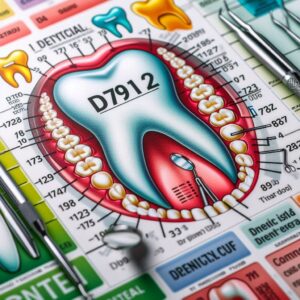Comprehensive Guide to D7912 Dental Code: Suture Removal and Post-Surgical Care
Dental procedures require precise coding for billing and insurance purposes. One such code, D7912, refers to the non-complicated removal of sutures performed by a dentist or oral surgeon. While seemingly straightforward, proper suture removal is crucial for healing and preventing complications such as infection or delayed recovery.
This article provides an in-depth exploration of the D7912 dental code, covering its clinical significance, procedural steps, billing considerations, and patient care guidelines. Whether you’re a dental professional, student, or patient, this guide will enhance your understanding of post-surgical suture management.

2. Understanding the D7912 Procedure
Definition and Scope
The D7912 code is classified under the American Dental Association (ADA) Current Dental Terminology (CDT) as:
*”Non-complicated removal of sutures – by report.”*
This means the procedure is typically straightforward, involving the removal of sutures without complications such as embedded stitches, infection, or excessive tissue trauma.
When Is Suture Removal Necessary?
Sutures (stitches) are commonly placed after:
-
Tooth extractions (especially surgical extractions)
-
Gum grafts
-
Biopsies
-
Periodontal surgeries
-
Dental implant placements
Most non-absorbable sutures require removal within 7–14 days, depending on the procedure and healing progress.
3. Types of Sutures Used in Dentistry
Absorbable vs. Non-Absorbable Sutures
| Type | Description | Common Materials | Removal Required? |
|---|---|---|---|
| Absorbable | Dissolves naturally in the body | Chromic gut, Polyglycolic acid | No |
| Non-Absorbable | Must be manually removed | Silk, Nylon, Polyester | Yes (D7912 applies) |
Common Suture Materials
-
Silk: Soft but may cause more plaque accumulation.
-
Nylon: Less reactive, commonly used in oral surgery.
-
Chromic Gut: Absorbable, treated for slower dissolution.
4. Step-by-Step Suture Removal Process
Pre-Removal Assessment
Before removing sutures, the dentist evaluates:
-
Healing progress (no signs of infection or swelling)
-
Suture integrity (loose or still holding tissue)
Tools and Techniques
-
Sterile instruments (suture scissors, forceps)
-
Antiseptic rinse (chlorhexidine) to reduce bacterial load
-
Lifting the knot and cutting the suture near the gumline
-
Gentle extraction to avoid tissue damage
Post-Removal Care
-
Avoid vigorous rinsing for 24 hours
-
Maintain gentle brushing around the surgical site
-
Monitor for bleeding or discomfort
5. Potential Complications and How to Avoid Them
-
Infection: Redness, pus, or increased pain → Requires antibiotics.
-
Premature Removal: Can lead to wound reopening.
-
Suture Breakage: May leave fragments, requiring careful retrieval.
6. D7912 Coding and Billing Guidelines
-
Insurance Coverage: Many plans cover D7912 under post-surgical care.
-
Documentation Needed:
-
Date of suture placement
-
Reason for removal
-
Healing status notes
-
7. Comparison with Related Dental Codes
| Code | Description | Key Difference |
|---|---|---|
| D7911 | Complicated suture removal (e.g., infection) | More complex than D7912 |
| D7951 | Surgical repair of wounds | Involves new sutures, not removal |
8. Patient Education and Aftercare Instructions
Patients should:
-
Follow a soft diet for 1–2 days post-removal
-
Avoid smoking (delays healing)
-
Use prescribed mouthwash to prevent infection
9. FAQs on D7912 Dental Code
Q: Does suture removal hurt?
A: Most patients feel slight tugging but no significant pain.
Q: What if a suture is accidentally swallowed?
A: Non-absorbable sutures usually pass harmlessly; consult a doctor if concerned.
Q: Can I remove my own sutures?
A: No—improper removal can cause infection or tissue damage.
10. Conclusion
The D7912 dental code ensures proper billing for non-complicated suture removal, a critical step in post-surgical recovery. Understanding suture types, removal techniques, and aftercare helps prevent complications. Always consult a dental professional for safe and effective suture management.


